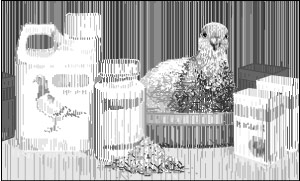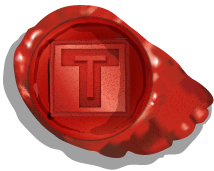
The Cure
Published:
Comments: 8 so far
Prior to every breeding season during September, October and November we put all the breeders through “The Cure.” We never pair the breeders without treating them.
First, I must point out that this treatment method is simply based on our opinion and experience. It may not be for you. It is not “vet approved.” It is simply what we do at Double T Lofts and it seems to work for us.
We are of the opinion that the birds must be in pristine health to produce championship-quality youngsters. We think this is especially true of the hens. It is the hen that must be able to supply sufficient nutrients for the fertilized egg to develop properly and ultimately hatch. Since we foster many of the eggs from the “better” and/or older pairs, the older birds are usually spared the duty of feeding youngsters. So, the ultimate goal of “The Cure” is to ensure super health that will result in quality, fertilized eggs that will hatch and produce pristine, championship-quality youngsters.
We will only breed from a hen that is in perfect health. This will include excellent feather quality over the entire body, bright white wattle, bright eyes, normal level of energy and good body weight. If they fail to meet these simple qualifications, they are not used. The only exception is to use an old hen that is near the end of her breeding life in hopes of raising another youngster or two from which to breed. We will not typically try to fly these youngsters, we are simply trying to “save the genes” in the hope of finding another excellent breeder.
Unless there is an obvious health problem, we typically treat for the following:
- General Infection(s)
- Canker
- Paratyphoid
- Worms (seldom)
- Coccidiosis (rarely)
Living in West Texas has health advantages for the birds. The climate is typically very dry. In the summer it is very hot and extremely dry. Our average rainfall is 9 to 11 inches per year. From September 2010 thru September 2011 we received a total of 2 inches – that’s dry. Given this dry climate, coccidiosis is rarely a problem. The breeders are on expanded metal floors, so worms are seldom a problem. This year (October 2011) I did treat for worms with Moxidectin for 1-day. That is all they received. There was no evidence that worms were present, but it had been a couple (or more) years since they had been treated.
TREATMENTS
- Typically, we start the treatment sequence with 10 days of terramycin and vitamins, which is the old “terramycin egg formula.” I specifically use terramycin, nothing else. The goal is to deal with intestinal and ovarian tract infections in the hens and as an overall general antibiotic for the minor infections that might be present in any of the breeders. Grit is removed while they are on terramycin. We do not remove grit for canker or paratyphoid treatment. Following this treatment they receive 2 days of probiotics to help restore the good bacteria. We do not use any of the “fancy” probiotics. We simply use one designed for birds and one that is rather inexpensive.
NOTE: We do believe probiotics are beneficial, but we do not place a large emphasis on the use of probiotics as part of our normal day-to-day use of supplements. They are given following any treatment to ensure they have the good bacteria restored. We do not give probiotics on a regular basis.
We typically wait for about a week before we start we start another medication.
- The next treatment is for canker. We use different medications from treatment-to-treatment so they do not become accustomed to the same product. The treatment is for 5 to 7 days and is again followed by 2 days of probiotics.
The different canker products we use include the following:
- Flagyl
- Metronidazole
- Emtryl (rarely)
We have never understood why many fanciers treat for canker after the first set of eggs have been laid and the birds are “setting” the eggs. It seems much better to have the birds treated prior to laying the eggs; much better for their health to be pristine prior to laying the eggs. I guess there must be a reason, but no one has ever shared it with us.
- The final, and perhaps the most critical (at least for us), is treatment for paratyphoid. Our treatment of choice is the Belgica DeWeerd product “Parastop” for 7 to 10 days. There are other similar products, but this is our favorite. The biggest drawback is the expense. This is an expensive product, unless you have only a small numbers of breeders. Again, we follow this treatment with 2 days of probiotics.
Pristine health is a year-around goal. Pristine health is exactly what our birds typically enjoy. We need to ensure the birds are healthy and present them with needed supplements, clean feed, clean grit, clean water and medicines accordingly. The purpose of “The Cure” is to prepare them for breeding. Their health should already be excellent, so this is our insurance policy for producing top quality youngsters and keeping the breeders in great health before, during, and after the breeding season is completed.
In addition to these treatments, and prior to pairing, we also do the following:
- Handle and evaluate all of the potential breeders.
- During the evaluation, the hens all receive a calcium tablet. They also receive a calcium tablet when they are paired and when they are separated. Typically the hens lay one round and are separated and rested for a month before their second round.
- All birds are sprayed for parasites with a solution of Permectrin. This is an extremely effective product. We typically do not have parasites as this spray is used several times each year on each bird.
The birds should be ready to breed following these treatments, provided they were generally healthy prior to starting “The Cure.”
Following “The Cure” and about 2 weeks prior to pairing the birds, the lights are turned on and the birds’ day is extended so they have about 14 hours of light. We also change the feed by decreasing barley and increasing the protein content to a more typical breeder mix.
Come back next month to read my follow-up article: Feeding and Handling the Breeders.

8 Responses to The Cure